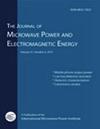微波处理对不同pH条件下紫苏籽粕中蛋白质和酚类物质碱性提取的影响:多组分分析优化研究
IF 1.5
4区 工程技术
Q4 ENGINEERING, CHEMICAL
Journal of Microwave Power and Electromagnetic Energy
Pub Date : 2023-10-02
DOI:10.1080/08327823.2023.2269493
引用次数: 0
摘要
摘要紫苏籽粕是紫苏冷榨油提取的副产物,含有丰富的蛋白质和生物活性物质。微波是一种高效的非常规技术,通常用于加速提取物的回收。本研究采用Box-Behnken设计优化pH、微波功率和处理时间,以最大限度地提高目标化合物的回收率。pH是影响产率最显著的变量,其次是微波功率和处理时间(基于f值)。在最佳提取条件为pH(11.5)、微波功率(160 W)和处理时间(30 s)的条件下,与常规碱性提取相比,黄芪多糖的蛋白质含量提高了10.58%,抗氧化活性提高了7.48%,总酚含量提高了21.59%。主成分分析表明,黄芪多糖的抗氧化活性与提取率呈负相关关系,表明提取率越高,黄芪多糖的生物活性越低。此外,从聚类分析中发现,与较低的pH值相比,在更极端的碱性条件下,微波处理的效果更低。因此,建议在较低的碱性条件下进行微波处理,以建立更好的萃取工业控制系统。研究了微波辅助提取法(MAE)对植物提取物的碱度、微波功率和暴露时间的影响,通过多组分分析发现,在较低碱度条件下,微波辅助提取法的蛋白质得率比传统的碱性提取法高10.5%,总酚含量比传统的碱性提取法高21.6%。微波辅助提取多组分分析紫苏籽粕抗氧化活性总酚含量蛋白质披露声明作者声明无利益冲突。本研究由种子基金项目资助,NIFTEM/院长研究/2020/ 2018,国家食品技术创业与管理研究所,位于印度哈里亚纳邦索内帕邦昆德里。本文章由计算机程序翻译,如有差异,请以英文原文为准。
Effect of microwave treatment on the alkaline extraction of proteins and phenolics from perilla seed meal in varying pH conditions: An optimization study using multicomponent analysis
AbstractPerilla seed meal (PSM) is a by-product rich in proteins and bioactive compounds obtained by cold pressed oil extraction method. Microwave is an efficient nonconventional technology usually used to accelerate the recovery of the extracts. In this study, pH, microwave power and treatment time were optimized to maximize the recovery of targeted compounds using Box–Behnken design. The pH was found to be the most significant variable affecting the yield followed by microwave power and treatment time (based on F-value). Compared to conventional alkaline extraction, an increase in the yield of protein content by 10.58%, antioxidant activity by 7.48% and total phenolic content by 21.59% was recorded at the optimal values of pH (11.5) microwave power (160 W) and treatment time (30 s). Moreover, principle component analysis revealed opposite correlation between antioxidant activity and extraction of protein/phenolics suggesting the loss of bioactivity at the higher yield of extracts. Also, from the clustering analysis, the effect of microwave treatment found to be lower in more extreme alkaline conditions compared to lower pH values. Hence, lower alkaline conditions are suggested for the microwave treatment to develop better control system in the extraction industry.HighlightsPlant extracts are frequently obtained using microwave-assisted extraction (MAE)Alkalinity level, microwave power and exposure time were analyzedMulticomponent analysis revealed optimum microwave treatments at less alkaline conditionsThe protein yield was 10.5% higher while total phenolic content was 21.6% higher than conventional alkaline extraction in optimum microwave conditionsThe MAE is recommended to obtain a high recovery of extracts with minimum degradationKeywords: Microwave assisted extractionmulticomponent analysisperilla seed mealantioxidant activitytotal phenolic contentproteins Disclosure StatementThe author declares no conflict of interest.Additional informationFundingThis research was funded by the Seed money project, NIFTEM/Dean Research/2020/18, National Institute of Food Technology Entrepreneurship and Management, Kundli, Sonepat, Haryana, India.
求助全文
通过发布文献求助,成功后即可免费获取论文全文。
去求助
来源期刊

Journal of Microwave Power and Electromagnetic Energy
ENGINEERING, CHEMICAL-ENGINEERING, ELECTRICAL & ELECTRONIC
CiteScore
2.50
自引率
6.70%
发文量
21
期刊介绍:
The Journal of the Microwave Power Energy (JMPEE) is a quarterly publication of the International Microwave Power Institute (IMPI), aimed to be one of the primary sources of the most reliable information in the arts and sciences of microwave and RF technology. JMPEE provides space to engineers and researchers for presenting papers about non-communication applications of microwave and RF, mostly industrial, scientific, medical and instrumentation. Topics include, but are not limited to: applications in materials science and nanotechnology, characterization of biological tissues, food industry applications, green chemistry, health and therapeutic applications, microwave chemistry, microwave processing of materials, soil remediation, and waste processing.
 求助内容:
求助内容: 应助结果提醒方式:
应助结果提醒方式:


